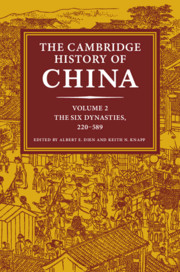Book contents
- The Cambridge History of China
- Copyright page
- Contents
- Figures and Tables
- Maps
- Preface
- Six Dynasties Chronology
- Introduction
- Part 1 History
- Part 2 Society and Realia
- Part 3 Culture, Religion, and Art
- Chapter 22 Confucian Learning and Influence
- Chapter 23 Qingtan and Xuanxue
- Chapter 24 Buddhism
- Chapter 25 Daoism
- Chapter 26 Popular Religion
- Chapter 27 The World of Prose Literature
- Chapter 28 The World of Poetry
- Chapter 29 Art and Visual Culture
- Chapter 30 Music
- Abbreviations of Frequently Cited Primary Sources
- Journal Titles: Acronyms (single-word titles do not use acronyms)
- List of Asian Journal Titles
- Primary Texts
- General Bibliography
- Glossary–Index
Chapter 24 - Buddhism
from Part 3 - Culture, Religion, and Art
Published online by Cambridge University Press: 28 October 2019
- The Cambridge History of China
- Copyright page
- Contents
- Figures and Tables
- Maps
- Preface
- Six Dynasties Chronology
- Introduction
- Part 1 History
- Part 2 Society and Realia
- Part 3 Culture, Religion, and Art
- Chapter 22 Confucian Learning and Influence
- Chapter 23 Qingtan and Xuanxue
- Chapter 24 Buddhism
- Chapter 25 Daoism
- Chapter 26 Popular Religion
- Chapter 27 The World of Prose Literature
- Chapter 28 The World of Poetry
- Chapter 29 Art and Visual Culture
- Chapter 30 Music
- Abbreviations of Frequently Cited Primary Sources
- Journal Titles: Acronyms (single-word titles do not use acronyms)
- List of Asian Journal Titles
- Primary Texts
- General Bibliography
- Glossary–Index
Summary
During the Han, preceding the Six Dynasties period, the picture of Buddhism that scholars have pieced together in recent decades remains peculiar and puzzling, in many respects decidedly different from Chinese Buddhism of later periods. As near as we can tell from what fragmentary evidence we have, the monastic community in the Han was composed primarily of foreign monks, surrounded by small groups of otherwise unknown Chinese. “Monasteries” were mostly ordinary homes that had been donated by devotees, no different in structure and appearance than any other grand house. Translations were carried out independently by monks, seemingly working on their own, far removed from more sophisticated Chinese literary circles. The scriptures they chose to translate, while fascinating both for the style of translation and for what they reflect about the Buddhist community in China and the state of Buddhism outside China, had little impact on subsequent Chinese Buddhist history and were, for the most part, seldom read. At court, Buddhism was of little consequence but was mentioned in passing for its “gentle offerings” of fruit, incense and flowers in place of animal sacrifice; by the end of the Han even the emperor made offerings to Buddhist images, but associated them with the Yellow Emperor and Laozi (Huang–Lao).
- Type
- Chapter
- Information
- The Cambridge History of China , pp. 531 - 552Publisher: Cambridge University PressPrint publication year: 2019

